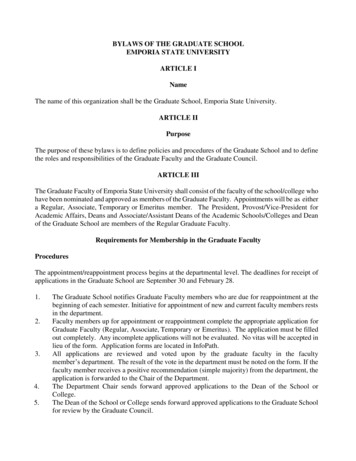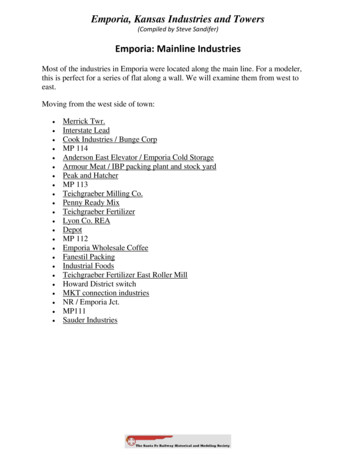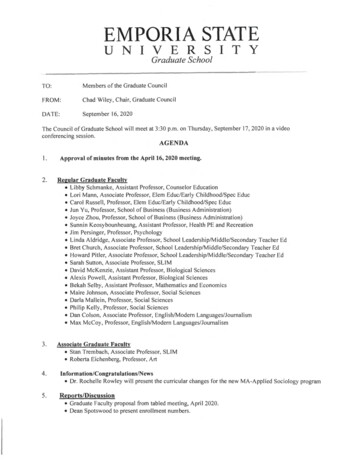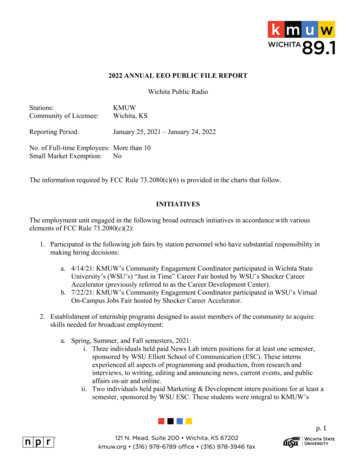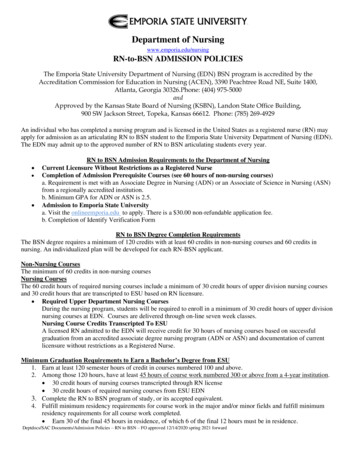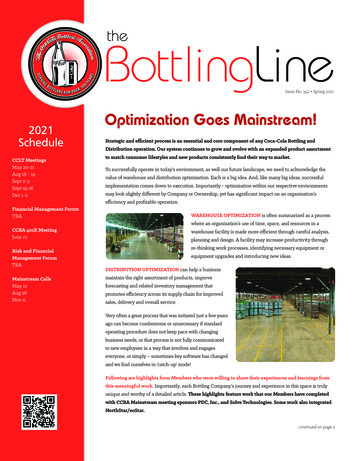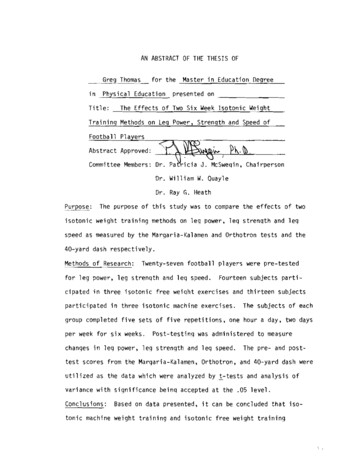
Transcription
AN ABSTRACT OF THE THESIS OF Thom for the Master in Education Degreein Physical EducationTitle:presented onThe Effects of Two Six Week Isotonic WeightTraining Methods on Leg Power, Strength and Speed ofAbstract Approved:. \1·Committee Members: Dr. \JPa icia J.IMcSwegin, ChairpersonDr. William W. QuayleDr. Ray G. HeathPurpo :The purpose of this study was to compare the effects of twoisotonic weight training methods on leg power, leg strength and legspeed as measured by the Margaria-Kalamen and Orthotron tests and the40-yard dash respectively.Methods of Research:Twenty-seven football players were pre-testedfor leg power, leg strength and leg speed.Fourteen subjects parti cipated in three isotonic free weight exercises and thirteen subjectsparticipated in three isotonic machine exercises.The subjects of eachgroup completed five sets of five repetitions, one hour a day, two daysper week for six weeks.Post-testing was administered to measurechanges in leg power, leg strength and leg speed.The pre- and post test scores from the Margaria-Kalamen, Orthotron, and 40-yard dash wereutilized as the data which were analyzed by i-tests and analysis ofvariance with significance being accepted at the .05 level.Conclusions:Based on data presented, it can be concluded that iso tonic machine weight training and isotonic free weight training
methods using five sets of five repetitions, one hour a day, two daysper week for six weeks produced no significant gains in mean leq power,leq strength and leq speed.Also, neither method of weight traininqproved to be significantly more effective than the other.This invest iqator's failure to induce a qain in strength, power and/or speed miqhthave been from inadequate training stimulus and intensity.
THE EFFECTS OF TWO SIX WEEK ISOTONIC WEIGHT TRAININGMETHODS ON LEG POWER, LEG STRENGTH ANDLEG SPEED DF FOOTBALL PLAYERSA ThesisPresented tothe Division of Health, Physical Education,Recreation, and AthleticsEMPORIA STATE UNIVERSITYIn Partial Fulfillmentof the Requirements for the DegreeMaster in EducationbyGreg W. ThomasNovember, 1983
.tepartment/ ccJl.udk.- ZT;.u,11- updt ".'f"p 'gc,'o . 'f't.- 441861i.' .
ACKNOWLEDGEMENTSI extend my deep thanks and appreciation to Emporia State Uni versity Physical Education administration and faculty and in partic ular Drs, Patricia J. McSwegin, William W. Quayle and Ray G. Heath,who gave me more than I could expect of their time, effort, andcooperation. in addition to their continuing encouragement, whichimproved my writing and research.Thanks must also be extended toJohn Baxter whose advice and assistance were invaluable.Also, a special thanks to the 1982-1983 Emporia State Universityfootball players and staff who were involved in this study.Grat itude is extended to them for their superb cooperation, positiveattitudes and efforts in making this a successful experience.Finally, I want to express my love and appreciation to my wife,Lorye Thomas.Over the past several months, she supported and en couraged me in my academic endeavors.portant in the achievement of my goals.Her support has been very im
CONTENTSPageChapter1.INTRODUCTION1Theoretical Formulation1The Problem2.Statement of the Problem2Statement of the Hypothesis3Assumptions of the Study3Purpose of the Study3Significance of the Study4Definition of Terms4Oekan Timer . . .4Isometric Exercise4Isotonic Exercise5Leg Curl5Leg Extension5Orthotron Machine5Strength5Speed . .5Weight Training5Limitations of the Study5Methods6an ProceduresPopulation and Sampling6Equipment and Facilities7Design and Procedure of the Study7Data Analysis . . . . .9
ChapterPage2.REVIEW OF RELATED LITERATURE113.ANALYSIS OF DATA. . .18Margaria-Kalamen Test18Orthotron Test4.20Forty Yard D a s h .22Analysis of Variance24SUMMARY, CONCLUSIONS, AND RECOMMENDATIONSSummary . DIXESA.Informed Consent FormB.Workout Recording FormC.Margaria-Kalamen Raw DataD.Orthotron Raw DataE.Forty Yard Dash Raw DataF.Analysis of Variance for Margaria-Kalamen, Orthotron,and Forty Yard Dash for Both the Machine and FreeWei ght Groups . . . . . . . . . . . . . . . . . .282932
TABLESPageTable1.Means and Standard Deviations on Machine andFree Weight Exercise Groups on Margaria-Kalamen . . . 192.t-table for Margaria-Kalamen Scores for Machine- and Free Weight Groups.3.Means and Standard Deviations on Machine andFree Weight Exercise Groups on Orthotron Machine19. .214.t-table for Orthotron Machine Scores for Machineand Free Weight Groups. . . . . . . . . 215.Means and Standard Deviations on Machine andFree Weight Exercise Groups on Forty Yard Dash. . .236.t-table for Forty Yard Dash Scores for Machine- and Free Weight Groups.237.Analysis of Variance Pre-Test on Margaria-Kalamenfor Machine and Free Weight Groups.50Analysis of Variance Post-Test on Margaria-Kalamenfor Machine and Free Weight Groups . . . . . . . . .50Analysis of Variance Pre-Test on Orthotron forMachine and Free Weight Groups . . . . .51Analysis of Variance Post-Test on Orthotron forMachine and Free Weight Groups518.9.10.11.12.Analysis of Variance Pre-Test on Forty Yard Dashfor Machine and Free Weight GroupsAnalysis of Variance Post-Test on Forty Yard Dashfor Machine and Free Weight Groups. . .5252
Chapter 1INTROOUCTIONThis chapter is devoted to information concerning the relation ship between the effects of two isotonic weight training methods onleg power, leg strength and leg speed of college football players.The statement of the problem, the null hypothesis, the assumptions,purpose, and significance of the study are discussed. Also includedis the definition of terms.Theoretical FormulationIn the past 25 years, strength and speed training have becomean integral part of athletic training programs.Oue to the recog nition of the importance of strength and speed development in thepreparation process for athletic participation. a wealth of informa tion relating to the areas of weight training is available.However,there is minimal research that actually compares isotonic free weighttraining to isotonic machine weight training designed to improve legpower, leg strength and leg speed.In all types of vigorous activities, the athlete's leg strengthand speed are of particular importance to performance of the activity.The development of the athlete's strength and speed has been a majorconcern ever since the days of the Romans, when lifting of heavy ob jects was the chief means of obtaining overall strength for the phys ical combats of their day (Gaines, 1974).Athletes in activities suchas football. basketball, soccer and rugby depend upon their legs forquick, powerful movement.For this reason, the different concepts of1
2improving the athlete's leg strength and leg speed have been of greatinterest to both the athlete and the coach in these particular sports.This study compared the effects of two types of isotonic resistanceprograms, free weights and machine weights, on development of legpower, leg strength and leg speed.The ProblemWeight training has become a basic element in the training pro gram of athletes for almost every sport.Much research has been con ducted, investigating how various weight training methods can help anathlete gain muscular strength, power and speed.However, there hasbeen little investigation of the effects of isotonic training withfree weights as compared to the effects of isotonic training on amachine.Is there a significant difference between the isotonic machinemethod and the isotonic free weight method of weight training indevelopment of leg power and leg strength?Also, is there a signifi cant difference between the isotonic machine method and the isotonicfree weight method of weight training in development of leg speed?These questions have created a need for resecrch in this area.Statement of the ProblemIs there a significant difference in the scores of leg power,leg strength and leg speed for football players who participated inthe machine method of weight training as compared to the scores ofleg power, leg strength and leg speed for football players who part icipated in the free weight method of weight training?
3Statement of the Hypothesis(Null Form)There is no significant difference in leg strength and leg speedscores of subjects using the isotonic machine method of weight train ing (MM) as compared to the leg power, leg strength and leg speedscores of subjects using the isotonic free weight method of weighttraining (FW).Stated symbolically, the null hypothesis was:H:a4MM 4FWwhile the alternate hypotheses were:H:1H:24 :4MM4MMFW"4FWAssumptions of the StudyThe following are basic assumptions made in the study:1).Subjects tested put forth their best effort while performingall tests and exercises.2).Subjects tested did not participate in any extra leg weighttraining exercises for the six week period.3).The total work by all subjects in the study was comparable.4).There was an increase in leg power, leg strength and legspeed from both methods of isotonic resistance training.Purpose of the Studj[The primary purpose of this investigation was to compare theeffects of two methods of isotonic weight training on the developmentof leg power, leg strength and leg speed in college-aged male football
4players.Twenty-seven subjects were divided into two groups performingthe identical number of sets and repetitions.machine method.Group MM used an isotonicGroup FW used an isotonic free weight method.Significance of the StudyLeg power, leg strength and leg speed are important physical at tributes in the modern game of football.For example, leg power andleg strength in linemen and leg speed in the receiver and defensiveback positions are important factors for successful performance inthese positions.Due to the relationship between these physical attri butes and individual end team success, the best possible equipment andprograms to increase leg power, leg strength and leg speed need to bedetermined.This study provides information that contributes to plan ning of an effective isotonic weight training program for improvementof leg strength, power and leg speed.The findings of this study willbe valuable to coaches and administrators who are considering the pur chase of weight training equipment specifically designed to developleg musculature.Definition of TermsThe following definition of terms applies in this study;Dekan Timer.A timing device used in the Margaria-Kalamen testto time a subject's speed of ascent from the third step to the ninthstep.Isometric Exercise.A contraction of a muscle in which there isno change in the angle of involved joint(s) and little or no changein the length of the contracting muscle (Lamb, 1978).
5Isotonic Exercise.A contraction of a muscle in which a constantresistance is moved through the full range of motion of the involvedjoint(s) (Lamb, l Q78).Leg Curl.A contraction of the hamstring muscles resulting infull flexion of the lower leg at the knee.Leg Extension.A contraction of the guadricep muscles resultingin full extension of the lower leg at the knee.Orthotron Machine.This testing device isolates the knee jointproviding isokinetic resistance in both directions for safe, controlledrehabilitative exercise or testing.Speed.The rate in time at which something moves, in this in stance legs.Strength.The force that a muscle or muscle group can exertagainst a resistance in one maximal effort (Fox, 1981).Weight Training.The term weight training is in reference to asystematic plan of working weighted exercises for development of mus cular strength and endurance.Specifically for this study, weight train ing was directed toward the development of strength of the lower body.Limitations of the StudyThe primary limitations of this study were that the physical act ivities of the subjects, aside from the leg power, strength and speed pro grams, were not controlled.The subjects engaged in a wide variety ofphysical activities during the time of the study.Such variation inexercise programs could affect the results of the study.However, if
6anything, one would expect such activities to increase strength.Methods and ProceduresThe purpose of this study was to compare the effects of twomethods of isotonic weight training on the development of leg strengthand leg speed.The remainder of this chapter describes the methodsand procedures to be used in the study.It includes information aboutpopulation and sampling, equipment and facilities. design of thestudy, and data analysis.Population andSamp1i The subjects for this study were randomly selected from theEmporia State University football team.The sample consisted of agroup of 30 males varying in academic classification from secondsemester freshman to second semester juniors.this study all had at eastSubjects involved inone year of uncontrolled and unsupervisedweight training experience.The isotonic free weight training groupacd the isotonic machineweight training group were formed by random sampling of the original30 subjects prior to the pre-test.15 subjects.Initially both groups containedThree subjects were released from this investigationdue to injury leaving 13 free weiqht subjects and 14 machine weightsubjects.Subjects in the investigation volunteered with the under standing that they could withdraw from the study at any time.Datawere recorded on coded score sheets in such a manner that the infor mation could not be identified with any specific subject, therebyassuring confidentiality.
7Equipment and FacilitiesThe equipment used in this study consisted of one Continentaladjustable weight and height scale, one 100-foot measuring tape,three American stopwatches, one Orthotron machine. two leg extensionand leg curl machines, one MGI leg press machine, two free weightsquat racks, one Dekan timer, and 1500 pounds of plate weight.The entire weight training program was conducted in the weight room facilities at Welch Stadium, located on the north side ofEmporia State University campus.Adequate space was available toaccomidate five lifters simultaneously.Design and Procedure of the StudyEach subject wasinstruct dby the experimenter concerningterminology, methods, techniques, and procedures to be followed forthe duration of the weight training program.Before performing anypre-testing or weight training, each subject signed an informedconsent form and were reminded of the importance of their full coop eration while being administered a test or performing an exercise.Subjects were pre-tested the weeK of January 31 to February 4,1983, on the Orthotron machine, Margaria-Kalamen power test, andforty-ya ddash.The Orthotron test was performed in the trainingroom at Emporia State university's Physical Education building.Orthotron machine tested leg power and leg strength.TheEach partici pant was allowed two warm-up kicks before performing any experimentaltrials.The subjects then were given three kicks with each leg.sum of the best score from each leg, expressed in foot-pounds, wasused as the score to be analyzed.The exercise was performed at aThe
8speed setting of "2" equalling 12 0 per second (2 RPM).The Marqaria-Kalamen step test represents an objective measureof lower body power.Power is simply a product of strength and speed.Therefore, an increase in power is indicative of an improvement inmuscular strength and/or speed.SUbjects performed this test in thePhysical Education building on a set of twelve steps located in thesoutheast part of the building.Before performing any trials eachsubject was weighted in his uniform of participation.Each of thesubjects began by standing six meters in front of a series oftwelve steps.On command, the subject ran as quickly as possible upthe stairs, stepping on every third step.A Dekan timer started whenthe subject's foot struck the switchmat on the third step and stoppedwhen his foot struck the switchmat on the ninth step.The elapsedtime represented the time required to move the body weight the verti cal distance between the third and ninth steps.Power was calculated by the following:Power(kgm/sec)Body Weight (kg) x Vertical Distance (meters)Elapsed Time (sec)The final test was the forty-yard dash representing a measureof leg speed.The test was administered with three individual timers,using the average time of all three stopwatches as a sinyle score.Warm-ups were a one-quarter mile jog andf veminutes ofl qstretches.Each participant ran in lane two on the east side straight-away ofWelch Stadium.The first session of weight training was conducted on Monday,February 7. 1983.All subjects had been instructed by the experimenterin the proper methods and techniques for the resistance training that
9they were to employ.During the six week period, a daily workoutsheet was posted at each exercise station to inform the subjects ofthe pounds of weight to be lifted.Subjects exercised under thesupervision of the experimenter and two Emporia State Universityfootball coaches.Each isotonic free weight subject performed exer cises of leg squats, leg curls, and leg extensions with free weights.Each isotonic machine subject performed exercises on the leg press,leg curl, and leg extension machines.in the weight training sessions.Two days per week were spentThe subjects completed five setsof five repetitions at each station.The weight was determined ac cording to the subject's ability at five RM (repetition maximum).When the subject was able to handle the weight load at five repeti tions of five sets, the subject's workload was increased five to tenpounds.Upon conclusion of the sixth week, post-testing was admin isterea March 21 through March 25, 1983.Da ta Ana 1ys i sThe data collected in this study were analyzed to compare theeffects of the machine weight training method and the free weighttraining method for the development of leg strength and leg speed.Analysis of leg strength was based on results made in the test per formance of the subject's Margaria-Kalamen power test and test per formance on the Orthotron machine.Tr.e forty-yard dash performancewas used for the analysis of speed.The scores from the post-test were utilized to compute the meansand significant difference between the means.The !-test for inde pendent samples was used to determine if the obtained information hadsignificant difference between the pre- and post-test (differences)
10scores of both isotonic groups.Analysis of variance (ANOVA) was usedalso to test for significant differences between the means of the iso tonic groups which contained different sample sizes.
Chapter 2REVIEW OF RELATED LITERATUREThe value of weight training for development of muscular strengthwas initially demonstrated by both Capen and Chui (1956, 1950).Chui(1950) developed a study to determine the effects of systematic freeweight training on strength.The control group was 29 students whowere members of a conditioning class.Forty members of the experi mental group exercised with free weights.three exercises,Each group participated inthree days a week for six weeks.Results from thisexperiment showed significant improvement in strength through system atic free weight training.Four different ten week isotonic weight training programs wereobserved by Capen (1956) to determine which was superior in regard tostrength development.For each exercise, individuals in Group I wererequired to select the heaviest weight which they could performimum number of eight repetitions. max Each subject worked toward a goalof 15 repetition at the starting weight.Upon achjeving their goal,a new eight-repetition maximum was determined and further exercisewas undertaken to again increase strength and the number of repetitions.Group II began the experiment in the same manner as Group I, how ever for each exercise, subjects selected the heaviest weight whichthey could perform a maximum number of five repetitions.Upon exercising,an increase in strength enabled subjects to achieve six repetitionsand a new five-repetition maximum was determined.11
12The subjects in Group III selected the heaviest weight whichthey could perform a maximum number of five repetitions.The sub jects then performed three sets with this selected weight, performingas many repetitions as possible in the second and third sets.Group IV subjects selected the heaviest weight which they couldlift only once.After executing the exercise with the maximum weight,the weight was decreased slightly for the second set and the subjectperformed as many repetitions as possible.Results indicated thatthe gain in strength from each of the four groups was almost equal.In Payne's (1968) study the purpose was to determine which eightweek exercise program, either isotonic or isometric, was the mosteffective in improving strength and speed of movement.Subjects usedin this study were 72 eighth grade girls, ages 12 to 13 years, enroll ed in three physical education classes.Group I was assigned as theexperimental isotonic group performing an average of six exerciseseach period.Group II was the control group which played gamesduring the experimental period.Group III was the experimentalisometric group performing an average of six exercises each periodwith isometric contract;ons that were h ld eight seconds.Arm andshoulder girdle strength were measured by the vertical pull, push andpull hand dynamometer, and the bent arm hang.Speed of the dominantarm was measured by the timing of ten round trip horizontal arm move ments between two boards standing upright two feet apart.was recorded to the nearest one-tenth of a second.The scoreThe results ofthe training program indicated an increase in the mean performanceof strength which was related to the increase of speed in all threegroups with the isotonic group being superior.
13Hooks (1962) points out that isotonic weight training canpossibly improve strength and speed simultaneously.A six week weighttraining program that overloads the muscle with enough weight toensure strength gains, and at the same time enables the muscles tocontract successfully with a burst of speed, will produce increasesin strength and speed.Hooks conducted experiments at Wake ForestUniversity with boys from all skill levels, ranging from groups ofthe very poorest physically fit subjects in the freshman physicaleducation classes to the most advanced varsity athletes.Resultsfrom this study indicate that there is a close relationship betweenincreased muscle speed and participation in a concentrated weighttraining program.In one experiment, a class of 27 of the poorest students wastested in the sixty-yard dash, after which the subjects participatedin a supervised isotonic weight training program for three days aweek for six weeks.running.During this time they were encouraged to do noAt the end of the six week period, theythe sixty-yard dash.T ewe eretested ondifference between the mean score for thesecond test was a decrease in time of 0.28 seconds resulting in anincrease in speed.In another experiment by Hooks, the varsity football team didnot register the same dramatic results, but did show an improvementin speed.The subjects were pre-tested in the forty-yard dash re presenting a measure of speed.Theyth nparticipated in a sixweek program of isotonic weight training, after which they werepost-tested on the dash.The differences between the pre- and post test means was a decrease of 0.22 seconds.
14Reade and Alley (1962) undertook an experiment to determinethe effects of isotonic weight training upon the starting speed oftwenty-two football players.After two weeks of early fall condi tioning practice, the players were tested on how rapidly they couldcharge one yard from a four point stance and hit a blocking dummywith either shoulder.This maneuever was timed electrically.Im mediately following the first testing. groups were divided at randominto a control group and a experimental group.The experimentalgroup took part in football plus a short weight training programthree times per week for six weeks.At the completion of the foot ball season the subjects were retested.Analysis of data showedthat weight trainers increased starting times significantly as com pared to the non-lifters.Masley, Hairabedian, and Donaldson (1953) attempted to determinewhether isotonic weight training was accompanied by an increase inmuscular coordination and speed of movement.Group I subjects en gaged in an eight week isotonic weight training program stressingmoderate poundage and repetitions.skills of volleyball.Group II engaged in learningFrom the data they presented, it appears thatmuscular coordination and speed of movement are actually improvedafter a period of isotonic weight training.Fishbain (1960) studied the effects of a isotonic weight train ing program upon performance in the 35-yara dash.An experimentalgroup of twelve high school boys participated in a program involvingsix weight training exercises, four days a week for a nine week pe riod.All subjects were tested at the beginning and the end of theexperiment.The results showed the experimental group had a signifi cant decrease in times for the 35-yard dash.
15Clarke (1961) investigated the possibility of increased speeddue to strength development.In this study arm strength and speedin a lateral adductive arm movement were measured in 62 college menand retested ten weeks later.During this interval, half remainedinactive in order to provide a control group.The isotonic groupexercised three days a week using three different arm exercises.Theresults showed the average speed and strength of the training groupimproved significantly.In the arm movement studied, individualdifferences in the amount of change in strength had a low but sig nificant correlation with individual changes in maximal speed ofmovement.Costill and his associates (1968) designed a study to demonstratethe relationship which exists among selected tests of explosive legpower and leg strength.Power is simply a product of strength andspeed, therefore, an increase in power is indicative of an improvementin muscular strength and/or speed.The explosive leg strength testsemployed were the vertical jump, standing broad jump, forty-yard dashand the squatweight lift.The Margaria test of maximal anaerobicpower and maximal vertical velocity was used to measure the power pro duction of the legs.Subjects were 76 members of a physical condition ing program at Ball State University.Results showed that speed inthe forty-yard dash was related to vertical velocity and that power,as measured by the Margaria, was related to both strength and speed.Berger's (1962) data furnished support for the effectiveness ofvarious numbers of repetitions in isotonic weight training.dicate that fewer than 10 RM may be most effective.Data in Four, five orsix provide maximal results in terms of strength gain.deVries (1980) sets the optimal number of workouts per week at
16between three and five, depending on the amount of vigorous activitya given individual may be indulging in beyond the weight trainingprogram.This does not mean that five or more days per week willnot give additional benefits, but simply that, for health purposes,one gets the best return for the amount of time invested.Fox (1979) shows the results of a study using isotonic programsthat varied widely in sets and RM loads.Significant isotonicstrength gains were made in programs consisting of as few as one setat 2 RM loads and as many as 5 sets at 10RM loads.Provided thefrequency of exercise is within the proper bounds just cited, signi ficant strength gains can be expected to occur following weighttraining programs of six weeks or longer.Fox (1981) did further research concerning the optimum numberof sets and repetitions that would most effectively increase strength.These studies employed programs with a training frequency of threedays per week over a duration of eight to twelve weeks.It can beseen that the greatest improvement in strength is obtained fromthree sets, each with a 6 RM load.Generally it can be said thatthe optimal number of repetitions maximum lies somewhere betweenthree and nine.When different numbers of sets are combined withdifferent RM loads, several equivalent programs for strength canbe developed.After carefully examining the related literature, it was con cluded that a relationship exists between isotonic resistance exer cises in the form of weight training and increased muscular strengthand speed.However, the wide variety of sets and weight repetitions,number of days per week and total number of weeks never gave a single pecified combination of set of repetitions, days or weeks which gave
17maximum results.Certainly, the Hooks (1962), Fishbain (1960), Clarke(1961), and Chui (1950) studies utilized isotonic free weights suggest ing some type of relationship between six to ten weeks of weight train lng and an increase in strength and speed.Also studies by Fox (1962,1979) and Berger (1962) provided weight training programs which utilizedseveral different sets and repetitions.
Chapter 3ANAL SISOF DATAThis chapter contains the analysis of data for the Margaria Kalamen, Orthotron and Forty ardDash tests for both groups.The statistical procedures used for analysis included the t-testand analysis of variance.Margaria-Kalamen TestThe Margaria-Kalamen test was administered to the machine andfree weight exercise groups prior to and following a six week iso tonic weight training program.The mean power scores of the pre tests for each group were subjected to the t-test to determine ifa significant difference existed at the .05 level.Analysis of Margaria-Kalamen DataThe machine group had a mean of 193.23 kilograms per second(kgm/sec.) for the pre-test with a standard deviation of 20.10kgm/sec.The free weight exercise group had a pre-test mean of195.45 kgm/sec. and a standard deviation of 13.29 kgm/sec.Forthe post-test measures, the machine exercise gro
tributes in the modern game of football. For example, leg power and leg strength in linemen and leg speed in the receiver and defensive back positions are important factors for successful performance in these positions. Due to the relationship between these physical attri


